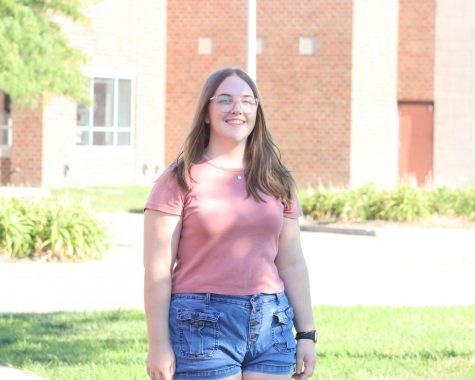Do your part to slow the spread
We need to keep up the fight against COVID
Everyone should continue to do whatever they can to slow the spread of COVID-19, whether that be through masking, sanitizing, vaccinating or social distancing.
September 16, 2021
At the beginning of the coronavirus pandemic, we were inundated by pleas from the scientific community: slow the spread, flatten the curve, stay six feet apart. Now, a year and a half later, we’re sick of hearing it. Pandemic fatigue has set in, and we’re desperate for a return to normalcy. Many of us have put our masks back in the closet, stopped hoarding sanitizer and started going back to concerts and parties.
Unfortunately, the pandemic is as strong as ever. Last month, five states broke records for their seven-day average of new daily COVID-19 cases. In August, total monthly positive cases across the country reached the fourth highest level since the start of the pandemic. Emergency rooms and hospitals are feeling the surge; around 9% of inpatient beds nationwide are occupied by COVID-19 patients. Children’s hospitals in particular are overwhelmed with the number of children hospitalized for COVID-19 being the highest it has ever been.
Despite the soaring numbers, all but five states are loosening restrictions. Stay-at-home directives and mask mandates are being lifted as case numbers rise and ICUs fill up. Clearly, governments across the country are unbothered by the death toll’s steady climb, but that doesn’t mean we have to be.
Regardless of what state or local ordinances say, we all need to continue to do our part to slow the spread. That may include hand-washing and sanitizing, masking, vaccinating, social distancing, contact tracing, testing, staying home when you’re sick and knowing the symptoms. Whatever it is that you can do to combat the pandemic, do it — if not for yourself, then for your community.
Even as numbers reach similar levels to the beginning of the pandemic, there is one key difference; we now have 18 months’ worth of evidence, research and trials that tell us what works and what doesn’t.
Dozens of studies conducted on the efficiency of masks have found that masking provides protection against coronavirus and that some masks are better than others. The Centers for Disease Control and Prevention found that N95 respirators block 99% of particles, medical masks block 59% and cloth masks block 51% while face shields block just 2%. Recent studies have also suggested that masking’s biggest impact is preventing sick people from spreading the virus. A study in Japan found that exposure was cut in half if an infected person wore a mask, and by 60 to 70% if those not infected also were also wearing masks. While masking is not 100% effective, research has shown that wearing a properly fitted mask with a proper filter will provide an extra layer of defense.
Similarly, extensive research on COVID-19 vaccines has found that while they may not be 100% effective, they do provide a significant level of protection. Despite fears that the vaccine was rushed, the COVID-19 vaccine trials followed normal safety testing protocols and in fact rank among the largest phase three vaccine trials ever recorded, with both the Moderna and Pfizer vaccine proving to be over 90% effective. State data has shown that the ten states with the lowest COVID-19 vaccine rates have the highest death and hospitalization rates in the country.
As the hospitalization rates for people under 18 rise, we as teens should be doing whatever we can to protect ourselves. While we may be less likely than older adults to become severely ill from coronavirus, the Delta variant, which is more contagious than previous strains, is cause for concern, especially as schools across the country reopen. Further, the long-term effects of contracting COVID-19 are still unknown, as is the cause of “long COVID,” where symptoms linger for weeks or even months.
If you’re not concerned about the risk COVID-19 poses to you, be concerned about the risk it poses to your community. The death toll in Nebraska is approaching 3,000. The lives we are losing to COVID-19 in Nebraska are the lives of friends, family and community members; they shopped at the stores we shop at, went to the schools we go to and worked at the places we work at. The healthcare workers who cared for them in the ICU or stood by their side while they were on ventilators are also suffering. For those of us who are getting tired of masking and social distancing, imagine what those workers feel like. They’ve been overloaded for a year and a half, and we take for granted that they stay strong throughout the course of the pandemic while we give up. Right now, healthcare workers and hospitals are overwhelmed, and when we choose not to do anything to slow the spread, we overwhelm the healthcare system’s capacity.
You don’t have to continue to take measures to prevent the spread of coronavirus, but you get to. This pandemic has shown massive divides across socio-economic classes. If you have access to the vaccine, if you are privileged enough to be back at school in-person to mask, if you are privileged enough to be in a position to social distance or self-quarantine when many essential workers can’t, then instead of seeing those things as chores, see them as a way for you to serve the community. See it as a privilege.
We can’t give up this fight yet. People are still dying. The U.S. death toll is expected to hit 750,000 by the end of 2021 — but we can still right the ship. We need to be doing everything we can to slow the spread. Whatever that means for you, do it — if not for yourself, then for your community.







